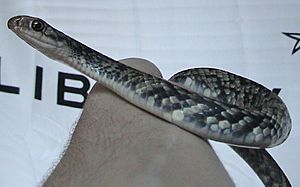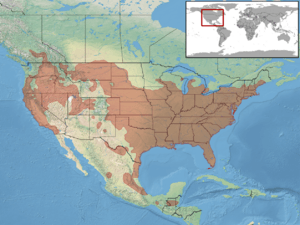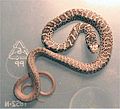Eastern racer facts for kids
Quick facts for kids Eastern racer |
|
|---|---|
 |
|
| Coluber constrictor anthicus, buttermilk racer |
|
| Conservation status | |
| Scientific classification | |
| Genus: |
Coluber
|
| Species: |
constrictor
|
 |
|
| Synonyms | |
|
|
The eastern racer (Coluber constrictor) is a type of nonvenomous snake that belongs to the Colubridae family. You can find these snakes only in North America and Central America. They are known for their incredible speed and curious nature.
Contents
What Does the Eastern Racer Look Like?
Eastern racers can grow quite long. They are usually about 50 to 152 centimeters (20 to 60 inches) in length. They typically weigh around 556 grams (1.2 pounds).
Their color can change a lot depending on where they live. They might be black, bluish, gray, or even olive brown.
Where Do Eastern Racers Live?
You can find eastern racers all over the United States, especially east of the Rocky Mountains. They also live north into Canada and south into Mexico, Guatemala, and Belize.
What Kind of Places Do They Like?
Eastern racers often live near water. However, they are very adaptable. You might also spot them in bushes, piles of trash, or along roadsides. They can even be found in swamps.
These snakes spend most of their time on the ground. But don't let that fool you! They are also excellent climbers. They might climb into shrubs and trees to look for bird nests.
Most eastern racers prefer open, grassland habitats. These open areas let them use their sharp eyesight and amazing speed. They usually stay close to a good hiding spot, just in case.
What Do Eastern Racers Eat?
Eastern racers are carnivores, meaning they eat other animals. Their main diet includes small rodents, frogs, toads, lizards, and even other snakes.
Some types of eastern racers are known to climb trees to eat eggs and young birds. Younger eastern racers have a different diet. They usually eat soft-bodied insects, like crickets and moths.
How Do They Catch Their Food?
When an eastern racer catches moving prey, it doesn't use venom. Instead, it wraps its body into one or two coils around the prey. This helps it hold the animal tightly so it can swallow it alive.
How Do Eastern Racers Behave?
Eastern racers are very fast and active snakes. They are also diurnal, which means they are most active during the day.
These snakes are quite curious. They have very good vision. Sometimes, you might see them raising their heads above the grass. They do this to get a better look at what is around them.
How Do They React to Danger?
When an eastern racer feels threatened, its first reaction is usually to run away. They are very hard to catch! If you try to hold one, it might poop or release a bad-smelling liquid from its cloacae. This is a defense mechanism to make predators let go.
How Do Eastern Racers Reproduce?
Eastern racers mate in the spring. This usually happens from April until early June.
The female snake lays her eggs in a hidden nest. She can lay anywhere from three to 30 eggs. These nests are often in places like a hollow log, an old rodent burrow, or under a rock. The young snakes hatch in the early fall. They become adults and can have their own babies when they are about 2 years old.
Images for kids
See also
 In Spanish: Culebra corredora constrictor para niños
In Spanish: Culebra corredora constrictor para niños











